check engine FIAT TEMPRA 1988 Service And Service Manual
[x] Cancel search | Manufacturer: FIAT, Model Year: 1988, Model line: TEMPRA, Model: FIAT TEMPRA 1988Pages: 171, PDF Size: 18.05 MB
Page 72 of 171
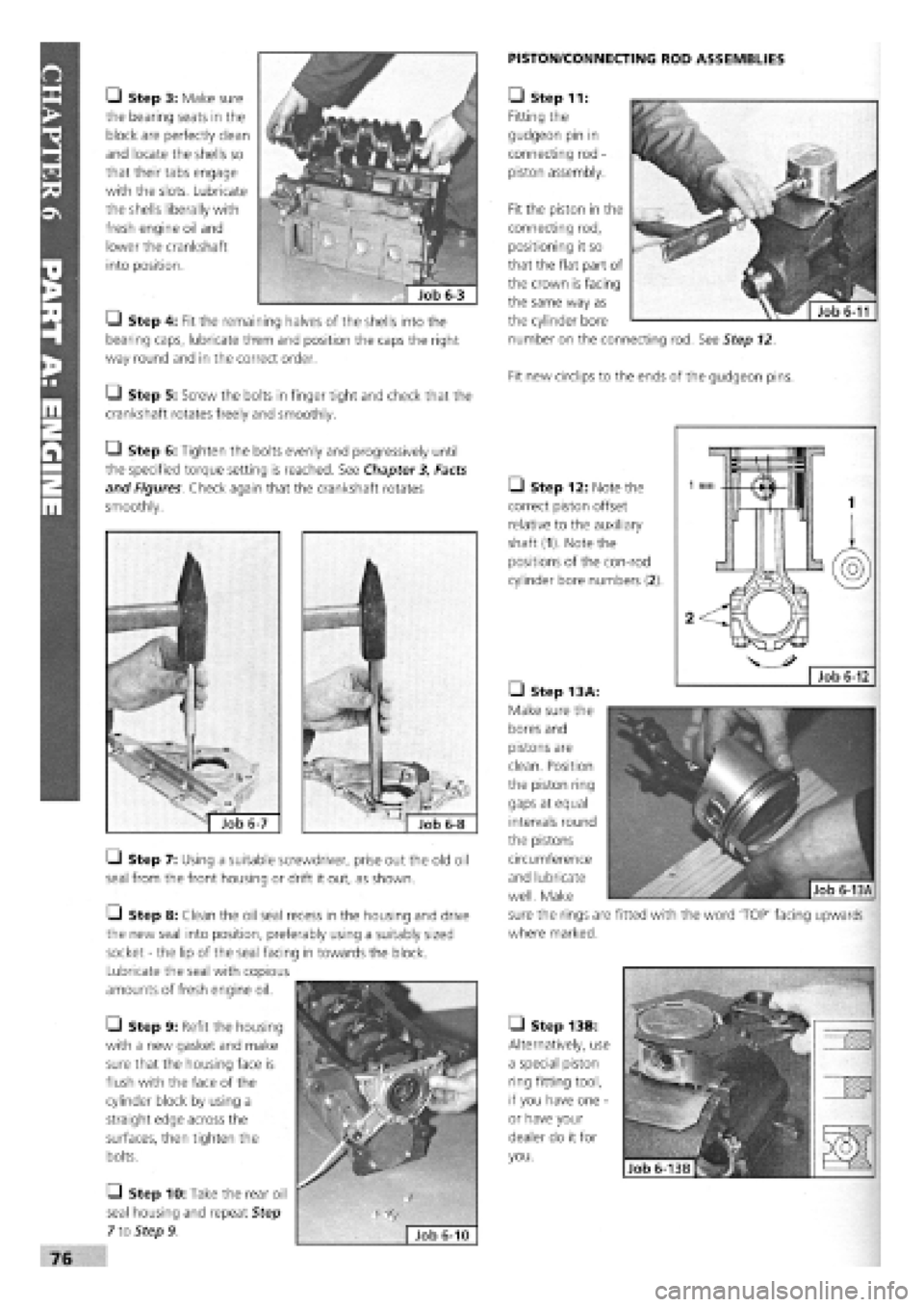
• Step 7: Using a suitable screwdriver, prise out the old oil
seal from the front housing or drift it out, as shown.
PISTON/CONNECTING ROD ASSEMBLIES
• Step 11:
Fitting the
gudgeon pin in
connecting rod -
piston assembly.
Fit new circlips to the ends of the gudgeon pins.
• Step 12: Note the
correct piston offset
relative to the auxiliary
shaft (1). Note the
positions of the con-rod
cylinder bore numbers (2).
Q Step 5: Screw the bolts in finger tight and check that the
crankshaft rotates freely and smoothly.
Q Step 6: Tighten the bolts evenly and progressively until
the specified torque setting is reached. See Chapter
3,
Facts
and Figures. Check again that the crankshaft rotates
smoothly.
• Step 3: Make sure
the bearing seats in the
block are perfectly clean
and locate the shells so
that their tabs engage
with the slots. Lubricate
the shells liberally with
fresh engine oil and
lower the crankshaft
into position.
• Step 4: Fit the remaining halves of the shells into the
bearing caps, lubricate threm and position the caps the right
way round and in the correct order.
Fit the piston in the
connecting rod,
positioning it so
that the flat part of
the crown is facing
the same way as
the cylinder bore
number on the connecting rod. See Step 12.
Job
6-12
• Step 13 A:
Make sure the
bores and
pistons are
clean. Position
the piston ring
gaps at equal
intervals round
the pistons
circumference
and lubricate
well. Make
sure the rings are fitted with the word 'TOP' facing upwards
where marked.
1
• Step 9: Refit the housing
with a new gasket and make
sure that the housing face is
flush with the face of the
cylinder block by using a
straight edge across the
surfaces, then tighten the
bolts.
• Step 10: Take the rear oil
seal housing and repeat Step
7 to Step 9
Q Step 8: Clean the oil seal recess in the housing and drive
the new seal into position, preferably using a suitably sized
socket
-
the lip of the seal facing in towards the block.
Lubricate the seal with copious
amounts of fresh engine oil.
• Step 13B:
Alternatively, use
a special piston
ring fitting tool,
if you have one
-
or have your
dealer do it for
you.
Page 74 of 171
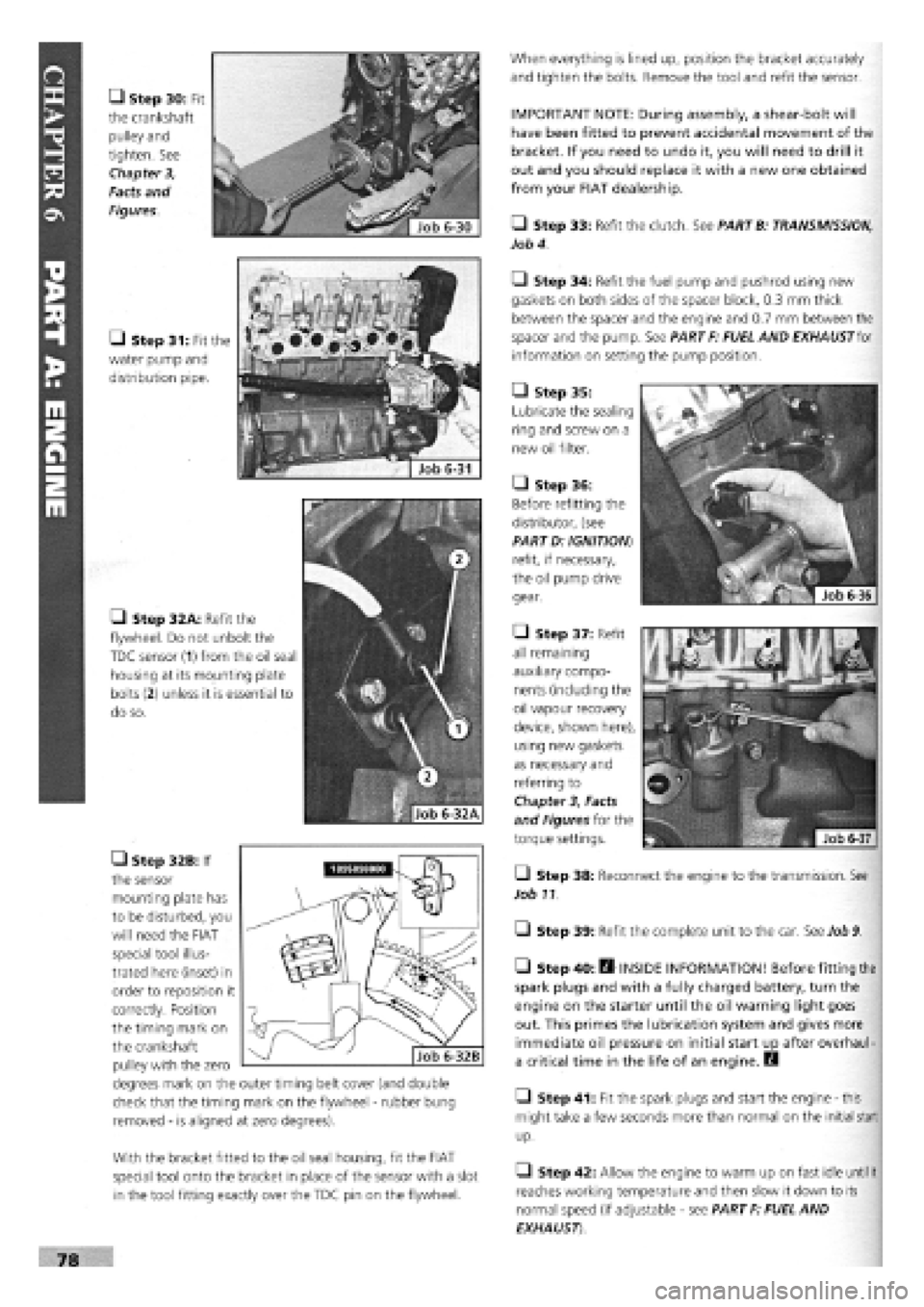
• Step 30: Fit
the crankshaft
pulley and
tighten. See
Chapter 3,
Facts and
Figures.
• Step 31: Fit the
water pump and
distribution pipe.
• Step 32A: Refit the
flywheel. Do not unbolt the
TDC sensor (1) from the oil seal
housing at its mounting plate
bolts
(2)
unless it is essential to
do so.
• Step 32B: If
the sensor
mounting plate has
to be disturbed, you
will need the FIAT
special tool illus-
trated here (inset) in
order to reposition it
correctly. Position
the timing mark on
the crankshaft
pulley with the zero
degrees mark on the outer timing belt cover (and double
check that the timing mark on the flywheel
-
rubber bung
removed
-
is aligned at zero degrees).
With the bracket fitted to the oil seal housing, fit the FIAT
special tool onto the bracket in place of the sensor with a slot
in the tool fitting exactly over the TDC pin on the flywheel.
When everything is lined up, position the bracket accurately
and tighten the bolts. Remove the tool and refit the sensor.
IMPORTANT NOTE: During assembly, a shear-bolt will
have been fitted to prevent accidental movement of the
bracket. If you need to undo it, you will need to drill it
out and you should replace it with a new one obtained
from your FIAT dealership.
• Step 33: Refit the clutch. See PARTB: TRANSMISSION,
Job 4.
Q Step 34: Refit the fuel pump and pushrod using new
gaskets on both sides of the spacer block, 0.3 mm thick
between the spacer and the engine and 0.7 mm between the
spacer and the pump. See PART F: FUEL AND EXHAUST for
information on setting the pump position.
• Step 35:
Lubricate the sealing
ring and screw on a
new oil filter.
• Step 36:
Before refitting the
distributor, (see
PART D: IGNITION)
refit, if necessary,
the oil pump drive
gear.
• Step 37: Refit
all remaining
auxiliary compo-
nents (including the
oil vapour recovery
device, shown here),
using new gaskets
as necessary and
referring to
Chapter
3,
Facts
and Figures for the
torque settings.
Q Step 38: Reconnect the engine to the transmission. See
Job 11.
Q Step 39: Refit the complete unit to the car. See Job
9.
• Step 40: fl INSIDE INFORMATION! Before fitting the
spark plugs and with a fully charged battery, turn the
engine on the starter until the oil warning light goes
out. This primes the lubrication system and gives more
immediate oil pressure on initial start up after overhaul-
a critical time in the life of an engine. B
• Step 41: Fit the spark plugs and start the engine
-
this
might take a few seconds more than normal on the initial start
up.
• Step 42: Allow the engine to warm up on fast idle
until
it
reaches working temperature and then slow it down to its
normal speed (if adjustable
-
see PART F: FUEL AND
EXHAUST)
Page 75 of 171

G Step 43: Stop the engine and allow it to cool, check the
oil
and coolant levels and look for any leaks.
G Step 44: Avoid over-rewing or overloading the engine
during its settling down period of 600 miles. We recommend
an oil
and filter change at this mileage
-
this will help to
extend the life of your new engine.
Job 7. Petrol engine.
Valve clearances - adjustment.
0 INSIDE INFORMATION! Adjustment should always be
made with the engine cold. B
G Step 1: Remove the camshaft cover and the spark plugs.
Jack up a front wheel and engage top gear. Turning the wheel
will rotate the engine and therefore the camshaft. If the
engine
is
out of the car, use a socket and long lever on the
crankshaft pulley nut. If the cylinder head is detached, turn
the
camshaft belt sprocket, by hand.
G Step 2: The inlet and exhaust valves use different clear-
ances
which are checked when each cam lobe is pointing
directly away from its follower. See Chapter
3,
Facts and
Figures.
G Step 3: The order in which the valves are fitted in the
cylinder head is:
Inlet: 2-3-6-7
Exhaust: 1-4-5-8
from
the timing cover end.
G Step 4: Select a feeler blade which is about the thickness
of the
correct valve clearance and insert it between the heel of
the cam
and the cam follower shim when the cam lobe is
uppermost. If necessary, select different thicknesses of feeler
blade until a small amount of drag can be felt as the blade is
pushed in and out. Record the total blade thickness. This is the
valve clearance for this valve.
G Step 5: Rotate the camshaft and repeat this operation on
each
of the remaining seven valves, noting their respective
clearances. Those which have clearances within limits
obviously don't need any further attention.
Q Step 6: The remaining valves will now need to have their
shims (arrowed) changed for thicker or thinner ones, bringing
their clearances to within the specifications shown in Chapter
3, Facts and Figures
Ll Step 7: A special tool is needed to depress the cam
follower and allow extraction of the shim. This is available
from your FIAT dealer, or you will have to make a lever with a
fork that locates nicely on the rim of a cam follower allowing
removal of the shim by prising it from the follower.
• Step 8: The
thickness of a shim
is engraved on it in
mm (arrowed). If
this is worn away,
you will have to
measure the
thickness with a
metric micrometer
-
or have your FIAT
dealer do it for you.
Your FIAT dealer can
also supply any new
thickness of shim
you may require.
• Step 9: Where
a clearance is too
small with the thinnest shim in position, the valves should be
removed and the stem ground just sufficiently to make the
correction. Your FIAT dealer can do this, keeping the end
square and retaining a smooth finish.
fjfefe^ | Job 7-10
Q Step 10: Be sure to use a new gasket when the cover is
replaced.
Page 78 of 171

Q Step 23: Undo the mounting bolts, making sure the
power unit is supported safely as you take the last bolts out.
• Step 24: Lower the power unit to the ground and pull
clear.
Job 9. Petrol engine/transmission
- refitting.
Q INSIDE INFORMATION! The power unit can be refitted
by simply reversing the order of the operations for
removal as set out in the previous job. However, the
following points should receive your attention as the
work progresses. H
• Step 1: Refer to Chapter
3,
Facts and Figures for the
torque settings when refitting the various components.
• Step 2: If you don't have the FIAT too! (arrowed) to fit
the special Oetiker bands on the drive-shaft boots, use
woodworker's pincers, or fit new jubilee clips and screw them
reasonably tight.
• Step 3: Check the condition of all hoses and clips and
replace them if suspect.
• Step 4: Make sure all the electrical connections are
correctly made and are sound.
Q Step 5: Make sure the engine and gearbox have the
correct grades and quantities of oil. See Chapter
3,
Facts
and
Figures.
Q Step 6: Check that the cooling system has the correct
coolant mixture. See Chapter
3,
Facts and Figures.
• Step 7: Make a final check that nothing has been left un-
connected before starting up.
• Step 8: Run the engine up to working temperature and
then switch off. Check for leaks and re-check the fluid levels
when cold.
Page 79 of 171
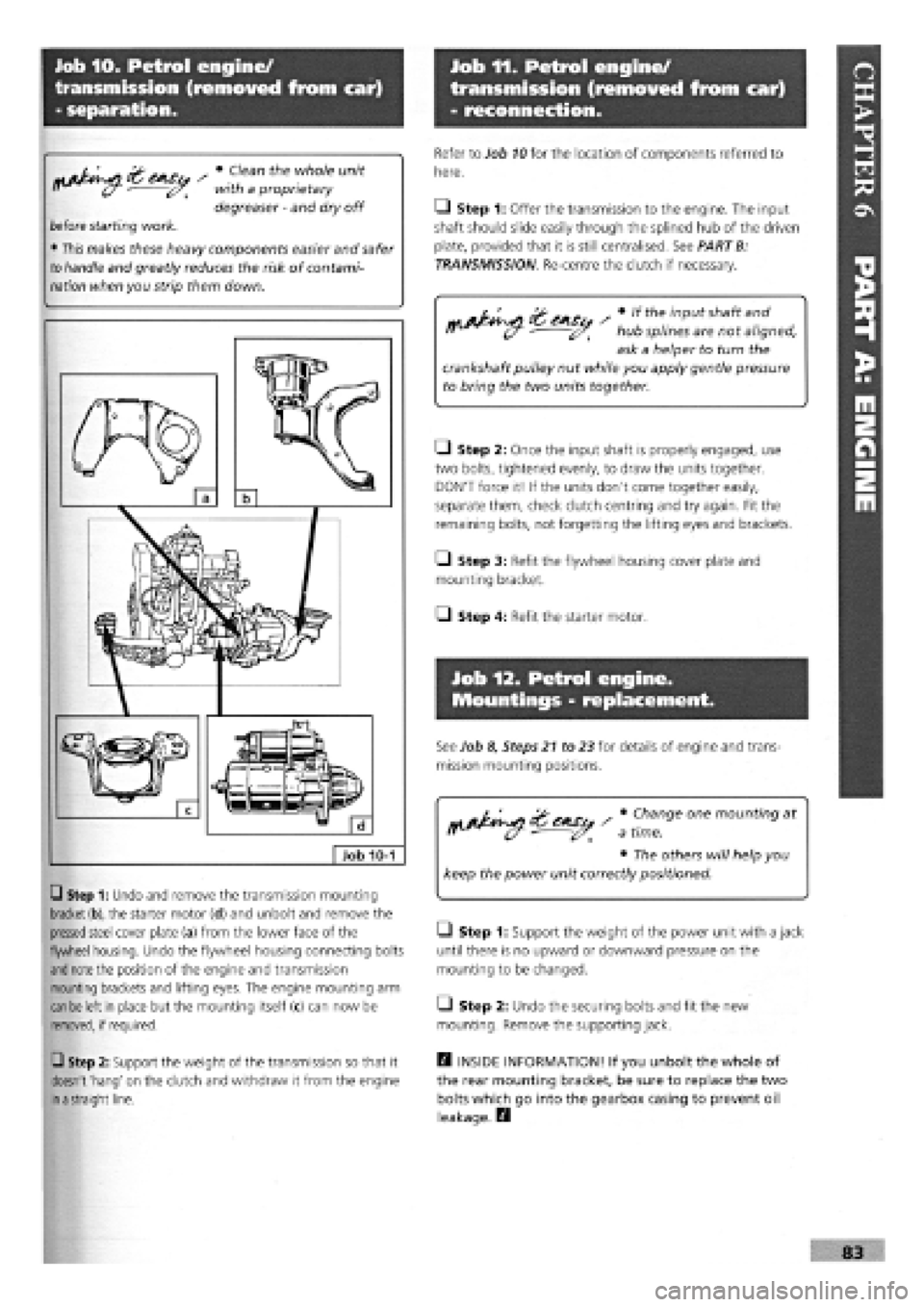
Job 10. Petrol engine/
transmission (removed from car)
- separation.
Job 11. Petrol engine/
transmission (removed from car)
- reconnection.
• Clean the whole unit
with a proprietary
degreaser
-
and dry off
before
starting work.
•
This
makes these heavy components easier and safer
to
handle
and greatly reduces the risk of contami-
nation
when you strip them down.
Job 10-1
Q Step 1: Undo and remove the transmission mounting
bracket (b),
the starter motor (d) and unbolt and remove the
pressed
steel cover plate (a) from the lower face of the
flywheel housing. Undo the flywheel housing connecting bolts
and note
the position of the engine and transmission
mounting brackets and lifting eyes. The engine mounting arm
can be
left in place but the mounting itself (c) can now be
removed, if required.
Q Step 2: Support the weight of the transmission so that it
doesn't 'hang' on the clutch and withdraw it from the engine
in a
straight line.
Refer to Job
10
for the location of components referred to
here.
• Step 1: Offer the transmission to the engine. The input
shaft should slide easily through the splined hub of the driven
plate, provided that it is still centralised. See PART B:
TRANSMISSION Re-centre the clutch if necessary.
r ' «the input shaft and
- hub splines are not aligned,
ask a helper to turn the
crankshaft pulley nut while you apply gentle pressure
to bring the two units together.
• Step 2: Once the input shaft is properly engaged, use
two bolts, tightened evenly, to draw the units together.
DON'T force it! If the units don't come together easily,
separate them, check clutch centring and try again. Fit the
remaining bolts, not forgetting the lifting eyes and brackets.
• Step 3: Refit the flywheel housing cover plate and
mounting bracket.
Q Step 4: Refit the starter motor.
Job 12. Petrol engine.
Mountings - replacement.
See Job 8, Steps 21 to 23 for details of engine and trans-
mission mounting positions.
Change one mounting at
time.
• The others will help you
keep the power unit correctly positioned.
• Step 1: Support the weight of the power unit with a jack
until there is no upward or downward pressure on the
mounting to be changed.
Q Step 2: Undo the securing bolts and fit the new
mounting. Remove the supporting jack.
H INSIDE INFORMATION! If you unbolt the whole of
the rear mounting bracket, be sure to replace the two
bolts which go into the gearbox casing to prevent oil
leakage. D
Page 80 of 171
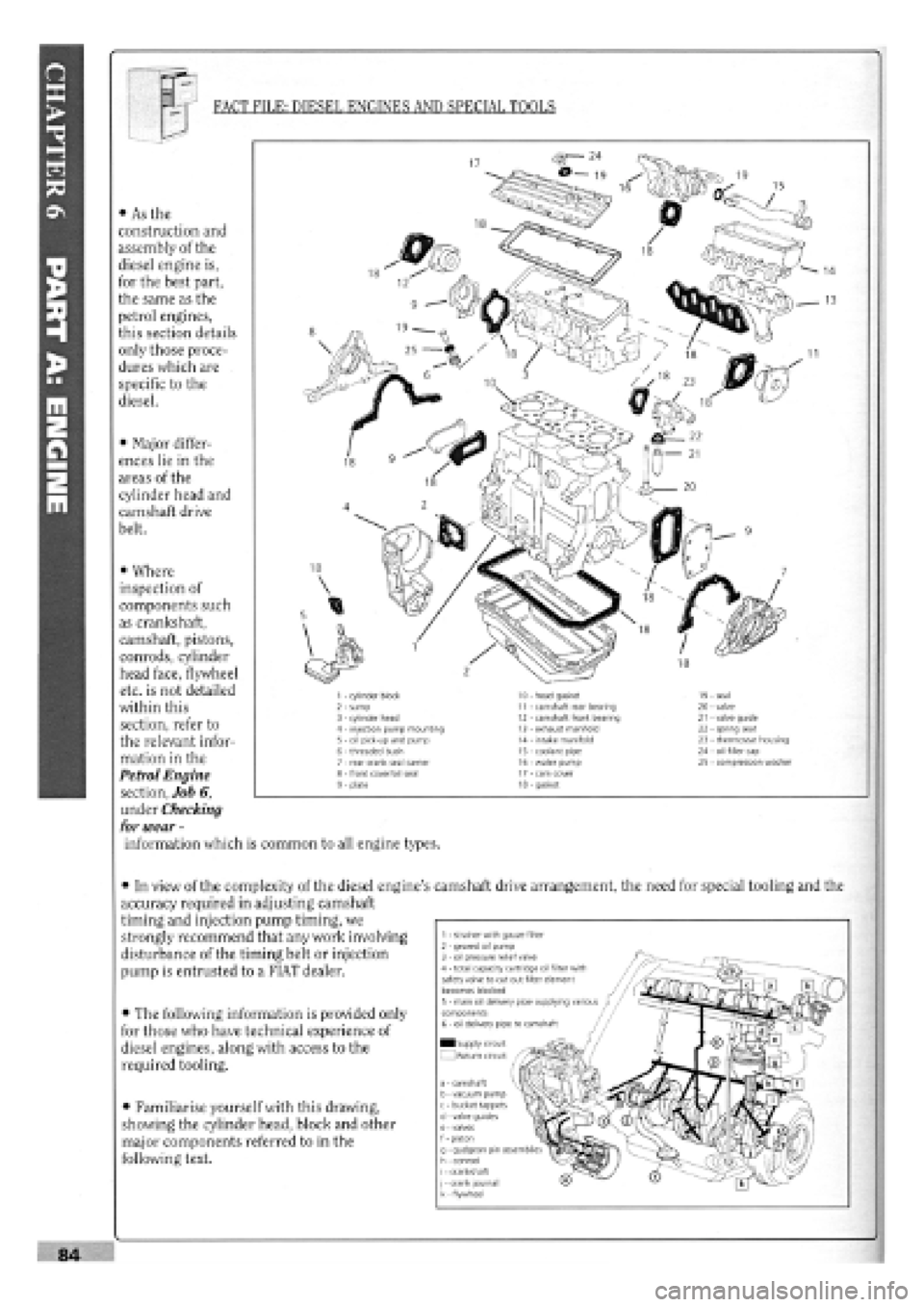
FACT FILE: DIESEL ENGINES AND SPECIAL TOOLS
• As the
construction and
assembly of the
diesel engine is,
for the best part,
the same as the
petrol engines,
this section details
only those proce-
dures which are
specific to the
diesel.
• Major differ-
ences lie in the
areas of the
cylinder head and
camshaft drive
belt.
• Where
inspection of
components such
as crankshaft,
camshaft, pistons,
conrods, cylinder
head face, flywheel
etc. is not detailed
within this
section, refer to
the relevant infor-
mation in the
Petrol Engine
section, Job 6,
under Checking
for wear -
information which is common to all engine types.
• In view of the complexity of the diesel engine's camshaft drive arrangement, the need for special tooling and the
accuracy required in adjusting camshaft
timing and injection pump timing, we
strongly recommend that any work involving
disturbance of the timing belt or injection
pump is entrusted to a FIAT dealer.
• The following information is provided only
for those who have technical experience of
diesel engines, along with access to the
required tooling.
• Familiarise yourself with this drawing,
showing the cylinder head, block and other
major components referred to in the
following text.
1
-
cylinder block 2
-
sump 3
-
cylinder head 4
-
injection pump mounting 5
-
oil pick-up and pump 6
-
threaded bush 7
-
rear crank seal carrier 8
-
front cover/oil seal 9
-
plate
10
-
head gasket 11
-
camshaft rear bearing 12
-
camshaft front bearing 13
-
exhaust manifold 14
-
intake manifold 15
-
coolant pipe 16
-
water pump 17
-
cam cover 18
-
gasket
19-seal 20
-
valve 21
-
valve guide 22
-
spring seat 23
-
thermostat housing 24
-
oil filler cap 25
-
compression washer
1
-
strainer with gauze filter 2
-
geared oil pump 3
-
oil pressure relief valve 4
-
total capacity cartridge oil filter with safety valve to cut out filter element becomes blocked 5
-
main oil delivery pipe supplying various / components 6
-
oil delivery pipe to camshaft
IHSupply circuit I
I Return
circuit
a
-
camshaft b
-
vacuum pump c
-
bucket tappets d
-
valve guides e
-
valves f
-
piston g
-
gudgeon pin assemblie; h
-
conrod i
-
crankshaft j
-
crank journal k
-
flywheel
Page 82 of 171

PART A
-
ENGINES PRIOR TO ENGINE NO. 1723291 • Step A15: Ease the timing belt off the sprockets.
Gl Step A10: Use a spanner on the crankshaft bolt (a) to
turn the engine until the timing marks on the crankshaft,
camshaft and injection pump sprockets align with their
respective reference marks. Align the crankshaft sprocket with
the notch on the front cover (b). Align the camshaft sprocket
with the hole in the timing belt cover (c). Align the injection
pump sprocket with the reference on the timing belt rear
guard (d).
• Step A11: Use
the FIAT flywheel
lock, part no.
1860766000 (or
construct your own
tool) to stop the
crankshaft from
turning.
• Step A12:
Remove the
alternator belt
pulley/damper.
• Step A13:
Using FIAT tool no.
1842128000 (see illustration Job
13-A10,
parte), lock the
injection pump sprocket to prevent it turning.
• Step A14: Slacken the belt tensioner nut (see illustration
Job
13-A10,
part f), move the tensioner away from the belt
and temporarily lock it in position.
• Step A16: Fit the new belt, first making sure that all of
the timing marks still align.
• Step A17: If you do not have access to the correct FIAT
tensioning tool, release the locknut, push the tensioner firmly
into the belt and lock it up by tightening its bolt.
If you do have the FIAT special tool (a weighted bar), attach it
to the tensioner, which will move to the position of correct
tension. Lock the tensioner bolt. Remove the special tool
locking the injection pump sprocket.
E3 INSIDE INFORMATION: If you can't put enough
pressure on the tensioner with your fingers, carefully use
a long screwdriver as a lever. Alternatively, push a pair of
bolts into the two holes in the tensioner and lever
between them to turn the tensioner. E9
Q Step A18: Rotate the engine through two revolutions. If
the belt is correctly tensioned you should just be able to twist
it through a quarter-turn when gripping it between thumb
and finger in the centre of its longest run between sprockets.
Adjust as necessary.
Q Step A19: Refit the remaining parts in the reverse order,
then check the injection timing (see Chapter
5,
Servicing
Your Car, Job
39)
PART B
-
ENGINES FROM ENGINE NO. 1723291-ON
Job 13-B10
Q Step B10: Turn the crankshaft in its normal direction of
rotation until the marks on the crankshaft sprocket (a) and
fuel injection pump sprocket (b) line up with the fixed marks
on the engine. This will place cylinder No. 1 at Top Dead
Centre TDC and set the camshaft for the power stroke of the
same cylinder. Lock the flywheel (see Step A11) and remove
the alternator belt pulley (see Step A12).
IMPORTANT NOTE: The hole for fixing the camshaft
sprocket (c) has a fine-adjustment slot, so it is possible
that the mark on the sprocket may not line up exactly
with the mark on the cover.
Page 83 of 171

Q Step B11: Undo the belt tensioner nut (see illustration
Job 13-B10, part d), then remove the timing belt.
Q Step B12: Undo the nuts securing the brake vacuum
pump to the cylinder head (see illustration Job
16-1),
and
remove it.
• Step B13: Fit FIAT tool no. 1860932000 (for setting
camshaft timing) to the vacuum pump end of the camshaft,
matching the camshaft groove (1) with the lug (2) on the tool
Secure
the tool to the cylinder head, positioning the centring
dowel
(3) as shown. The dowel must be perfectly centred on
the tool,
and if it isn't, you should adjust the hexagonal bolt
(4) with
a spanner, and centre it with tiny movements.
• Step B14:
Remove
the bolt
(arrowed) which
secures
the front
cover
to the engine
block,
then fit the
timing belt on the
crankshaft sprocket.
• Step B16:
Lock the injection
pump sprocket (see
StepA13). Now,
using FIAT tool no.
1860831000,
slacken the bolt
securing the
camshaft sprocket.
• Step B17: Continue fitting the timing belt in the
following sequence: crankshaft sprocket, fixed tensioner,
injection pump sprocket, timing sprocket, belt tensioner... and
check that the mark on the injection pump lines up with the
fixed mark on the rear cover.
• Step B18: Use the timing belt tensioner to correctly
tension the belt.
B INSIDE INFORMATION: If you do not have the correct
tensioning tool, follow Steps A16 and A17. B
• Step B19: Tighten the camshaft sprocket bolt to the 1
specified torque (see Chapter
3,
Facts and Figures).
Q Step B20: Turn the crankshaft by two revolutions
(clockwise), tighten the belt tensioner to the specified torque
(see Chapter
3,
Facts and Figures) and remove the
tensioning tools. If the belt is correctly tensioned you should
just be able to twist it through a quarter-turn when gripping it
between thumb and finger in the centre of its longest run
between sprockets. Adjust as necessary.
O Step B21: Refit the remaining components in the reverse
order of removal, then check the injection timing. See
Chapter
5,
Servicing Your Car, Job 25.
Job 14. Diesel engine.
Cylinder head - removal.
• Disconnecting the high pressure pipes on a diesel
injection system can be dangerous!
• Read the Safety First! information at the start of
PART F: FUEL AND EXHAUST SYSTEMS before
starting work.
Q Step 1: Refer to Job
13
and remove the timing belt.
• Step 2: Drain the cooling system and disconnect the air
pipes from the inlet manifold.
Q Step 3: Disconnect
and remove the oil vapour
pipes from the cylinder
block device.
Job 13-B13
• Step B15: Fit
FIAT tool
No.
1860933000 for
precise
determination
of TDC
on cylinder
No. 1. The
tool must
be secured
firmly by
two bolts
to the
crankshaft sprocket,
and by
another bolt
to the
crankshaft front cover (where the bolt was previously
removed in Step B14).
Page 85 of 171
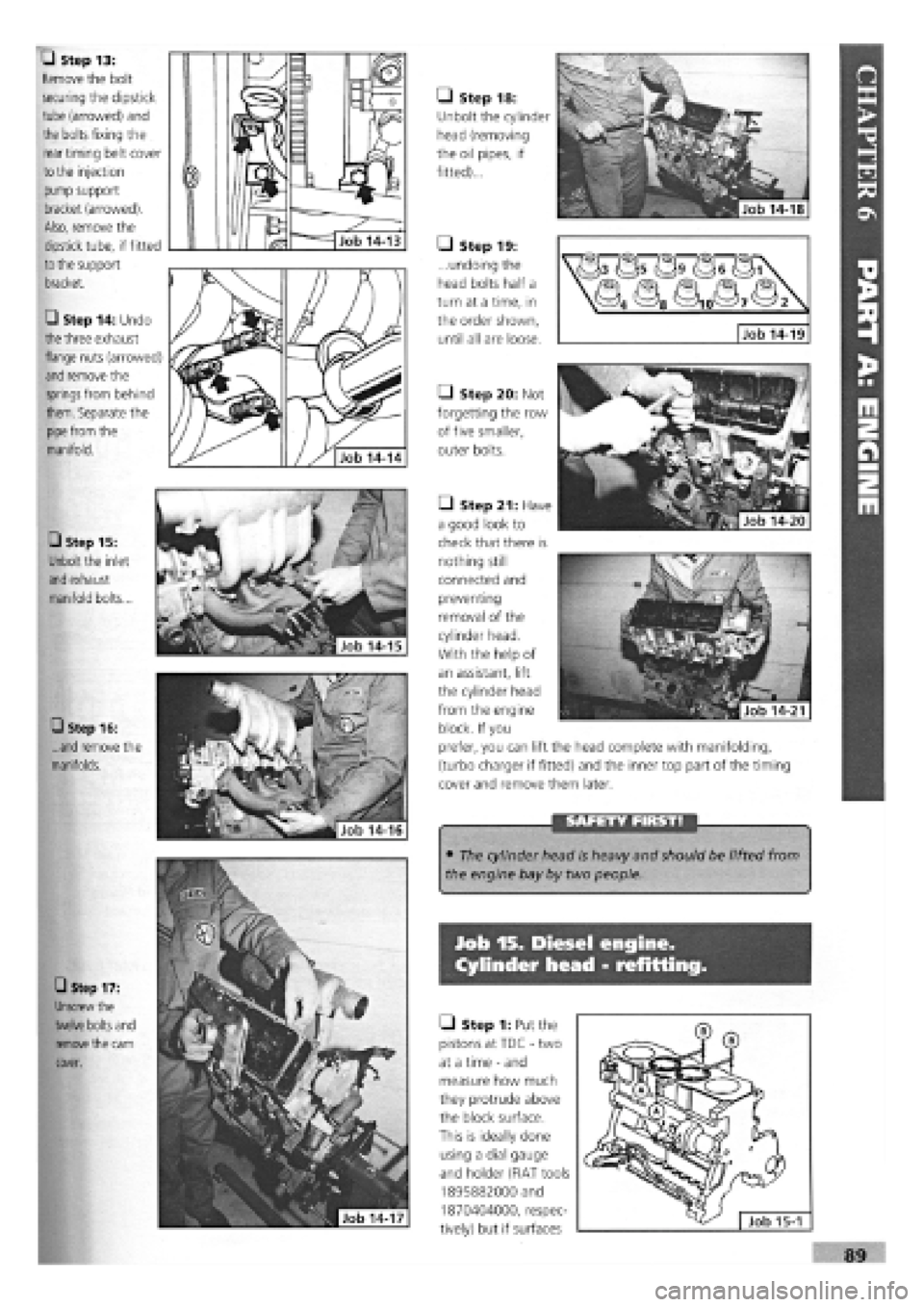
SAFETY FIRST!
• The cylinder head is heavy and should be lifted from
the engine bay by two people.
Job 15. Diesel engine.
Cylinder head - refitting.
• Step 1: Put the
pistons at TDC
-
two
at a time
-
and
measure how much
they protrude above
the block surface.
This is ideally done
using a dial gauge
and holder (FIAT tools
1895882000 and
1870404000, respec-
tively) but if surfaces
• Step 15:
Unbolt the inlet
and
exhaust
manifold bolts...
• Step 16:
...and remove the
manifolds.
• Step 17:
Unscrew the
twelve bolts
and
remove
the cam
cover.
• Step 18:
Unbolt the cylinder
head (removing
the oil pipes, if
fitted)...
• Step 20: Not
forgetting the row
of five smaller,
outer bolts.
• Step 13:
Remove the bolt
securing the dipstick
tube (arrowed) and
the bolts fixing the
rear timing belt cover
to
the injection
pump support
bracket (arrowed).
Also, remove the
dipstick tube, if fitted
to the
support
bracket.
• Step 14: Undo
the
three exhaust
flange nuts (arrowed)
and
remove the
springs
from behind
them. Separate the
pipe from
the
manifold.
• Step 19:
...undoing the
head bolts half a
turn at a time, in
the order shown,
until all are loose. Job 14-19
• Step 21: Have
a good look to
check that there is
nothing still
connected and
preventing
removal of the
cylinder head.
With the help of
an assistant, lift
the cylinder head
from the engine
block. If you
prefer, you can lift the head complete with manifolding,
(turbo charger if fitted) and the inner top part of the timing
cover and remove them later.
Page 86 of 171

are very clean, and great care is taken, it is possible to take an
average protrusion measurement based on measuring the
protrusion at each side (A) and (B) of the piston crown, using
a steel straight-edge and feeler gauges. Use the HIGHEST
average measurement of the four pistons as your working
figure.
Q Step 2: Now,
referring to the illus-
tration, select the
appropriate one of the
three available cylinder
head gasket thicknesses
as follows:
Measured protrusion
Up to 1.05 mm
1.05
-
1.20 mm
Over 1.20 mm
B INSIDE INFORMATION! The cylinder head gasket is of
the special 'ASTADUR' type and polymerises during
engine use, becoming much harder. It should only be
removed from its wrapping immediately before fitting
and then should be kept free of contamination by oil,
grease or water. Fit only between clean and dry cylinder
head and block surfaces. B
• Step 3: Discard the old gasket and thoroughly clean the
cylinder block mating surface and dry off. Make sure that the
bores are free of gasket particles.
B INSIDE INFORMATION! It is important to be sure that
all the cylinder head bolt holes in the block are clear
right down to their bottoms. The bolts and washers
should be cleaned, lubricated with engine oil and then
drained for at least 20 minutes before fitting. B
• Step 4: Clean the cylinder head, taking care not to gouge
the aluminium surface
-
use a straight edge that isn't too
sharp.
Q Step 5: Place the new gasket on the cylinder block with
the word 'ALTO' facing upwards.
• Step 6: Lower the head into position and screw all the
bolts in finger tight.
LI Step 7: Note the numbered tightening order of the ten
main cylinder head bolts. Using a suitable torque wrench,
proceed to tighten the ten main bolts in the following
sequence:
Stage i) Tighten to 50 Nm.
Stage ii) Tighten to 100 Nm.
• Step 8: Using
a suitable bar,
continue to tighten
IN EXACTLY THE
SAME ORDER AS
BEFORE, as
follows:
• Step 9:
Finally, using a
torque wrench,
Tighten the five
remaining smaller
bolts to 30 Nm.
Q Step 10: Now reverse the remaining steps in Job
74
to
reinstate all items removed or disconnected during removal of
the cylinder head. See Chapter
3,
Facts and Figures for
relevant torque figures and the coolant mixture and capacity.
• Step 11: Bleed the fuel system
-
refer to PART
F: FUEL
AND EXHAUST
• Step 12: Prior to initial start up, check that everything is
properly connected and secured. Run the engine to normal
working temperature, switch off and check all fuel lines and
coolant hoses for leaks. Allow to cool and check the coolant
level.
Gasket identification
No notches (1.65 mm gasket)
One notch (1.80 mm gasket)
Two notches (1.95 mm gasket)
Stage iii) Tighten
each bolt through
ninety degrees
(one quarter turn).
Stage iv) Tighten each bolt through a further ninety degrees.